preview
So: Oklahoma, possessor of the most terrifying quasi-ginger manbeast* in college basketball lo these many years, comes up against Michigan, possessor of exactly two guys over 6'5", only one of whom plays at a time. Yipes.
Though Kenpom's taking a beating in this year's tournament, it's worth noting that Oklahoma, at 15, is a weak 2-seed in according to the numbers. This is more like a 4-13 matchup than a 2-10. Which I have no idea whether that's better or worse. Given what happens with 4-13 games, we have around a 25% shot, which is about what Kenpom says anyway. FWIW, Oklahoma was only the third-best team in the Big 12 in terms of efficiency margin, finishing behind Kansas and Missouri.
*(I couldn't find a picture that showed it well. I am of the opinion that Griffin is pigmented oddly in a way that I can't put a finger on but is definitely ginger-esque.)
Michigan Offense vs Oklahoma Defense
Two pointers. Oklahoma's extremely good at defending them, 17th nationally at 42.3%, and extremely good at avoiding opponent trips to the line. Continuing a theme, the Sooners get a lot of blocks: 11.4%, 51st nationally.
Three pointers. Oklahoma gives up an average percentage but allows slightly more threes than the average bear.
Possession advantage. The one glaring deficiency on the Oklahoma resume is turnover percentage, at which they languish in the 300s. Opponents just don't turn the ball over, probably because Oklahoma's defense is considerably less in-your-face than that of Clemson or whoever. That makes sense. They can just funnel drivers to Griffin and rely on their outstanding two-point FG defense and rebounding to do the work without getting in foul trouble. This explains the FTA/FGA, too. Don't expect a whole lot of ball denial on the outside.
That defensive rebounding, by the way, is good but not outstanding. They're 119th, which is above average, but for a power conference team that plays a significant portion of its schedule against weaker schools it's probably just average when adjusted for opponent difficulty.
Well? Given Michigan's profile we should expect few turnovers, a ton of threes attempted, very few trips to the line, and the occasional offensive rebound. Sounds like any other Michigan game, actually. Key matchup is Sims versus Griffin; Michigan's going to need more than what Sims provided against Clemson, and it'll be interesting to see what happens if the Sooners try to play man to man and Sims drags Griffin out of the paint. The outside shooting threat Sims provides could seriously limit Griffin's effectiveness on the defensive end.
Oklahoma Offense vs Michigan Defense
Oh, lordy. While Michigan's offense has a decent chance of working just fine, the offensive numbers are intimidating.
Two pointers. Oklahoma makes 56% of its twos, fourth nationally, thanks to Griffin. He's hitting 64% of his twos(!). Oklahoma also has a huge FTA/FGA ratio that is also fourth nationally—they take a bunch of free throws. This is also thanks to Griffin, who is #1 nationally in fouls drawn per 40 minutes. This is probably not news, but: Blake Griffin is good.
Three pointers. Oklahoma's slightly above average at hitting 'em and slightly above average at taking 'em, likely symptomatic of opponents collapsing down on that Griffin guy and leaving open shots for the guys on the perimeter.
Possession advantage. IE: turnovers plus offensive rebounds plus free throw percentage. This is where it gets dicey. Oklahoma's slightly above average at taking care of the ball and pretty good but not obliteratingly good on the offensive boards: they rebound 36.5 of their misses, good for 52nd.
The somewhat good news is that all those free throws taken aren't hugely efficient. Unlike Manny Harris, Michigan's main source of FTs, Griffin has an encouragingly crappy time of it at the free throw line, shooting just 59%. Yes, this means that Griffin averages 1.28 points on an average shot and 1.18 points on an average trip to the line and sort of implies that Eric Puls should see the floor and foul out as quickly as possible, but that's before taking turnovers and stuff into account. It's probably close, though.
What do you do with this stuff? It doesn't appear that Oklahoma crushes the boards quite as much as Clemson did against Michigan. Aside from Griffin, who's an absolute vacuum defensively and very good offensively, they've got one other guy who plays much and hits the boards, and he's 6'7".
As far as Griffin goes, I guess you have to front him, double him constantly, prevent him from getting the ball, and possibly give him a ninja suplex to stop him. Any Michigan player with spare fouls should use them liberally should Griffin find himself in an advantageous position. Michigan's status as a team that uses a few different zones should help limit the damage Griffin can do, as they can switch between a few different defenses and confuse entry passes and the like from Oklahoma's young and not that great guards.
Miscellaneous Factors
Slidin', again. Michigan may be fortunate to have run across a team that, like Clemson, is sliding a bit as the season comes to an end. Oklahoma finished its year by losing four of six, including an opening-game loss to Oklahoma State in the Big 12 tourney. I wouldn't get too excited, though: all of those losses game to quality tournament teams and only the Kansas game was at home. This is not analogous to Clemson's situation, which saw the Tigers drop games against the likes of Georgia Tech.
Coachin'. The Beilein-as-tourney-mastermind meme continues with another upset for his hall of heads, albeit against the active coach with the worst PASE score in all the land. Jeff Capel doesn't have much of a record, but it's better than Oliver Purnell's:
- 2004: Capel gets VCU in as a 13 seed, where they lose to #4 Wake Forest by a single point.
- 2008: Oklahoma makes the field as a 6, handily beating St Joseph's in the first round before getting clubbed by Louisville 78-48.
Capel went to Duke, for whatever that's worth. Anger about someone else getting a good coach from Duke? General anger about the white Devils? I don't know.
Common Opponent. There was just one: Oklahoma beat Purdue 87-82.
The General Feeling Of Foreboding
Yeah, I've got it too. Or, rather, I've got it as much as anyone can have it when you're dealing with this Michigan basketball team that has exceeded expectations so massively.
Michigan finds itself facing a team poised to exploit their greatest weakness. I mean…
For being a scout team player that saw all of 20 minutes of floor time this season, Eric Puls got plenty of attention Friday afternoon.
The 6-foot-10-inch University of Michigan redshirt freshman played the role of Oklahoma forward Blake Griffin during Friday's practice session at the Sprint Center as the Wolverines prepared for tonight's NCAA Tournament South Regional test against the No. 2-seeded Sooners.
…greatest weakness, man. I am racking my brain for things Eric Puls has in common with Blake Griffin and can come up with two: being 6'10" and having a cardiovascular system.
Playing man to man against Griffin is a recipe for points on your face and Michigan is going to have to do that after misses and turnovers, though thankfully there probably won't be much in the way of turnovers. They don't even have the post depth to foul freely.
I can see Michigan staying in the game for a while, but I can also see that one deadly Oklahoma run that pushes a close game to an eight or ten point gap all too clearly. This is probably it, but hey: okay.
"OP has a posse" from Clemson b-ball blog the OP.
What Say Tempo Free Stats?
Tempo free stats say we gon' die. Clemson's ACC performance on a possession-by-possession basis was better than anyone not named Duke or North Carolina:
Opp.
Pace PPP PPP EM
1. North Carolina 74.7 1.16 1.01 +0.15
2. Duke 69.2 1.08 0.98 +0.10
3. Clemson 70.5 1.09 1.01 +0.08
4. Wake Forest 74.3 1.07 1.01 +0.06
5. Florida St. 69.1 1.00 0.98 +0.02
Meanwhile, Michigan was actually in the red in the Big Ten:
5. Ohio St. 60.8 1.07 1.05 +0.02 6. Minnesota 62.2 0.98 0.98 0.00 7. Michigan 61.0 1.01 1.03 -0.02 8. Penn St. 59.7 1.00 1.04 -0.04 9. Northwestern 59.6 1.03 1.07 -0.04
If you hold that the ACC and Big Ten are basically equivalent this year—generous—this bodes very unwell. I guess there's an argument that Clemson got way up there by whipping some teams badly and their week-in week-out performance is too erratic to take that number seriously, but, man, that's a big gap.
Kenpom also says this is a crappy draw for Michigan. It has Clemson the #22 team in all the land, which corresponds to a solid six seed in Tempo Free Ability Land, not the seven they got in reality. (This is not an attempt to imply the committee was wrong to make Clemson a 7; sometimes teams under- or over-perform their overall ability in the actual wins and losses. For example: Michigan, as you'll see.)
Michigan, meanwhile, is #49. If we took the top 65 teams by their ratings and broke them into seeds, this matchup would be a 6 versus a 13. Kenpom says we have a 32% chance of victory. This is considerably lower than the other ten seeds: Maryland has a 38% shot at Cal, Minnesota a 42% shot at Texas, and USC is actually a tempo-free favorite (65%) over BC.
Of course, these are just simple averages that take every possession in every game, adjust them for difficulty, and project future games based on that and a home/road adjustment. They don't take matchups into account.
So: matchups.
Clemson Defense vs Michigan Offense
Turnovers. Clemson's major distinguishing characteristic is a 40-minutes-of-hell full press that sees Clemson force a butt-ton of turnovers: 24.1 percent of opponent possessions end without a shot. That's 16th nationally. You can see the costs of this strategy in a couple spots: a generous 2PT FG percentage allowed (46.1%; 89th) and horrible defensive rebounding.
Three-pointers. Bad news for Michigan: Clemson does a good job of protecting the three-point line. Only 28% of opponent's shots are threes, which is 26th nationally. They do allow a good percentage when opponents get a look.
Inside the arc. As mentioned, Clemson's two-point percentage allowed isn't good despite (yet another) huge block percentage: 14%, 14th nationally. They offset that with a healthy rate of fouls.
Specific People Who Are A Specific Height. The good news for Michigan is that Clemson's main lineup isn't Illinois huge or anything: the starting lineup has a 6'7" guy and a 6'9" guy but no 7-foot menace, despite the shotblocking prowess. Sims defied earlier predictions here about an inability to combat seriously large posts when he tore up Minnesota, but he tore up Iowa even worse and was then reduced to a wide array of outside shots against very large Illinois, none of which went down. I'm still much more comfortable when Sims is dealing with an opponent of approximately the same size.
The big question. Grady? Kelvin Grady, once Michigan's starting point guard, struggled badly in Michigan's ugly stretch midway through the season and got benched in favor of CJ Lee and David Merritt. Grady's limited but has one grade-A skill: handle. Attempting to press him is a futile waste of time. Merritt and Lee… eh, not so much. Beilein's not likely to start Grady or anything, but if Clemson forces a couple of ugly turnovers early he might get exhumed.
Michigan Defense vs Clemson Offense
How much of the Tiger offense is turnover based?
Opponent turnovers don't translate directly into offense unless it's a steal, which can lead to a fast break opportunity. This took forever and came out with bupkis, but it took forever so look at the graph you bastards:
That's a scatter plot of Clemson's steals against their points per possession. Correlation: eh, eyeballing it… just about zero. Where the pressing will tell is in Michigan's offense, it appears.
Their turnovers. Eh… they're mediocre, turning the ball over on exactly 20 percent of their possessions. That's about the national average. Michigan forces opponents into 21% turnovers.
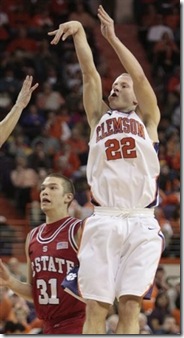 Three-pointers. Clemson's Terrence Oglesby (the near-albino guy at right) is an excellent shooter hovering around 40% on his long range attempts; this is a major component of Clemson's excellent three-point percentage: 38%, which is 35th nationally. They take a slightly above-average number of them.
Three-pointers. Clemson's Terrence Oglesby (the near-albino guy at right) is an excellent shooter hovering around 40% on his long range attempts; this is a major component of Clemson's excellent three-point percentage: 38%, which is 35th nationally. They take a slightly above-average number of them.
Michigan's been surprisingly effective at shutting down the three point line, though: 43rd in opponent makes and opponents get off a below-average number of triples. That might have something to do with…
Two pointers. Michigan is horrible at defending them, allowing opponents to shoot over 50%. Clemson is very good at getting them, making 51.4% of their attempts. Clemson's offense is mostly just good all around, with a high eFG and a very high offensive rebound percentage offsetting a crappy ability to get to the line and meh turnovers.
Miscellaneous Factors
Past performance, future results. I kind of hate the "X-factor" as a concept/cliche, but there's an X-factor here in how the teams react to styles they haven't seen before. Michigan hasn't been pressed consistently all year; Clemson hasn't seen the Beilein offense or the 1-3-1. A lot of people are banking on Beilein's tendency to overperform in the NCAA tournament to see Michigan through, and that's usually attributed to his unusual style.
via bracketscience and mvictors
Here's some Debbie Downer: it could just be chance. Beilein's only made it a few times and has done well, but he's pulled a couple fortunate matchups, with Northwestern State blowing up Iowa before the Mountaineers had a chance; WVU also missed the three-seed in '05 and had an opportunity against an 11 in '98.
The other side of the coin: Clemson coach Oliver Purnell is 0-fer in five trips to the tourney:
- 1992: 15 seed Old Dominion, a 15-15 team is clunked by #2 Kentucky.
- 2000: 11 seed Dayton loses to 6 seed Purdue by one point.
- 2003: 4 seed Dayton loses to 13 seed Tulsa by 13.
- 2008: 5 seed Clemson loses to 12 seed Villanova by 6.
The 1992 and 2000 trips don't raise eyebrows, but Purnell's suffered two straight upsets at the hands of inferior competition.
There's a case the coaches' historical performance is more than a fluke.
Sliding. Though Michigan hasn't exactly burned up the nets of late, they are 3-2 in their last five with wins over Purdue and Minnesota. Clemson, meanwhile, has been in free fall: 1-4 to finish the season with the win over horrible Virginia and the final loss an opening-round ACC tournament matchup against last place Georgia Tech.
Common opponents. These do not bode well, but mostly because they encompass Clemson's best performances of the year:
- Duke: Michigan split a neutral/home pair; Clemson obliterated the Blue Devils by 27 at home.
- Maryland: Michigan lost a road game; Clemson obliterated the Terrapins by 29 at home.
- Illinois: Michigan went 1-2, with a ten point win at home and ten point losses on the road and in Indy. Clemson scraped a two point road win over the Illini.
- Savannah State: Clemson clubbed them; Michigan won in overtime, barely escaping a tourney-killing loss.
Well?
This will be a big test of the Beilein-as-impossible-to-prepare-for meme, because Michigan drew a tough, tough seven seed. Fellow 10 seed USC is staring at an ACC team that managed to lose to Harvard (which who does that, really) and finished 7th in conference when it comes to efficiency margin. In contrast, Michigan draws a Clemson team that, while sliding a bit, beat some good teams absolutely raw and is a solid third in conference, above 4 seed Wake Forest.
Meanwhile, Michigan is the team that finished 7th in efficiency margin in its conference, and you can tack on some uncomfortably close victories in the nonconference to that. I think Kenpom is about right here: Michigan is a decided underdog.
Elsewhere:
- Clemson preview in the diaries.
- Aaand UM Hoops has his first look, too.
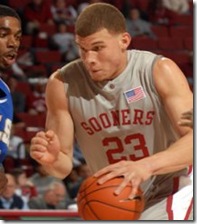


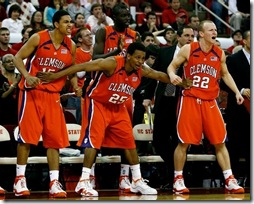
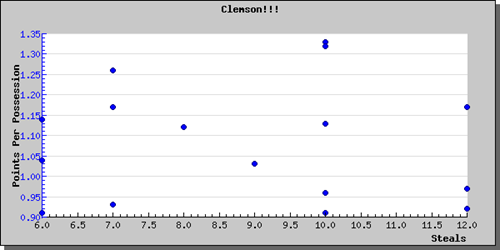
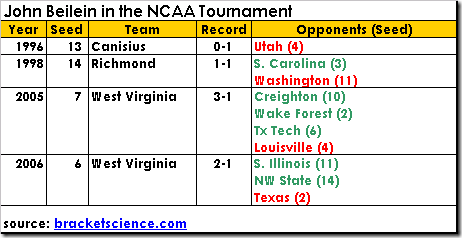
25